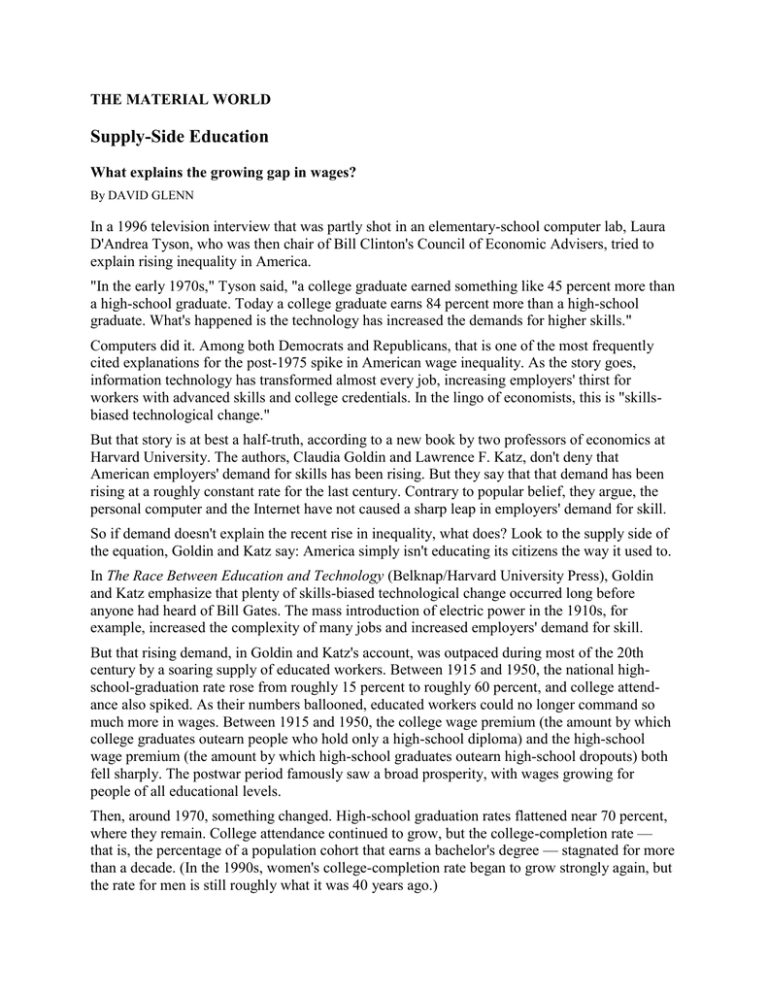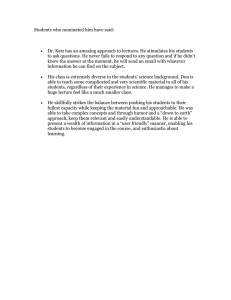What Explains the Growing Gap in Wages?
advertisement

THE MATERIAL WORLD Supply-Side Education What explains the growing gap in wages? By DAVID GLENN In a 1996 television interview that was partly shot in an elementary-school computer lab, Laura D'Andrea Tyson, who was then chair of Bill Clinton's Council of Economic Advisers, tried to explain rising inequality in America. "In the early 1970s," Tyson said, "a college graduate earned something like 45 percent more than a high-school graduate. Today a college graduate earns 84 percent more than a high-school graduate. What's happened is the technology has increased the demands for higher skills." Computers did it. Among both Democrats and Republicans, that is one of the most frequently cited explanations for the post-1975 spike in American wage inequality. As the story goes, information technology has transformed almost every job, increasing employers' thirst for workers with advanced skills and college credentials. In the lingo of economists, this is "skillsbiased technological change." But that story is at best a half-truth, according to a new book by two professors of economics at Harvard University. The authors, Claudia Goldin and Lawrence F. Katz, don't deny that American employers' demand for skills has been rising. But they say that that demand has been rising at a roughly constant rate for the last century. Contrary to popular belief, they argue, the personal computer and the Internet have not caused a sharp leap in employers' demand for skill. So if demand doesn't explain the recent rise in inequality, what does? Look to the supply side of the equation, Goldin and Katz say: America simply isn't educating its citizens the way it used to. In The Race Between Education and Technology (Belknap/Harvard University Press), Goldin and Katz emphasize that plenty of skills-biased technological change occurred long before anyone had heard of Bill Gates. The mass introduction of electric power in the 1910s, for example, increased the complexity of many jobs and increased employers' demand for skill. But that rising demand, in Goldin and Katz's account, was outpaced during most of the 20th century by a soaring supply of educated workers. Between 1915 and 1950, the national highschool-graduation rate rose from roughly 15 percent to roughly 60 percent, and college attendance also spiked. As their numbers ballooned, educated workers could no longer command so much more in wages. Between 1915 and 1950, the college wage premium (the amount by which college graduates outearn people who hold only a high-school diploma) and the high-school wage premium (the amount by which high-school graduates outearn high-school dropouts) both fell sharply. The postwar period famously saw a broad prosperity, with wages growing for people of all educational levels. Then, around 1970, something changed. High-school graduation rates flattened near 70 percent, where they remain. College attendance continued to grow, but the college-completion rate — that is, the percentage of a population cohort that earns a bachelor's degree — stagnated for more than a decade. (In the 1990s, women's college-completion rate began to grow strongly again, but the rate for men is still roughly what it was 40 years ago.) "There was enormous growth in educational attainment between 1900 and 1970," Goldin says in an interview. "But after 1970, the growth in attainment became much more sluggish. Putting those two parts together, you can explain a large amount of the story of wage inequality in the 20th century." "In the past few decades, technology has continued to move forward, but not that differently than in the past," Katz adds. Demonstrating that the demand for skill has been roughly constant for a century is a tall order, and it's the element of Goldin and Katz's book that is most likely to draw skepticism from their colleagues. Their argument draws partly on data from the Iowa state census, which was one of the few during the first half of the century to collect detailed statistics about educational attainment. (The national census did not do so until 1940.) Goldin and Katz concede that institutional features — trade policies, labor laws, and so on — have also helped to shape American inequality over the last century. But as a rough cut, they say, the simple supply and demand of skilled labor — the race between education and technology — tells most of the story. "Education has not kept pace," says Katz. "In the early 20th century, we created almost universal access to high school. We have not done the same with college, which essentially we would need to have done to have kept this sort of widespread prosperity present." One of the book's central questions is this: Given that the wage premiums for education have grown so strongly during the last 35 years, why haven't more young people responded by earning degrees? One answer, Goldin and Katz say, is that the short-term barriers to college are steeper than they once were. "Among the college-ready," Katz says, "we need to make sure that they have the financial support to get into college. We do an OK job with that, but we could do better. More than half of undergraduates work more than 20 hours a week. The loan burdens are tremendous. Tuition has been rising. It's clear that those things are taking a toll." A more difficult answer, Katz says, has to do with the weaknesses of American public-school education. "There are a myriad of possible reasons for that," he says. "Some people say it's all about resources. Some people say we need to improve incentives for parents and teachers. Clearly, over the long run, early-childhood intervention programs may be very important. We need a continuum of investments. But per dollar, we're not doing so well in the K-12 system in the U.S. these days." In a working paper released earlier this year, three Yale University economists — Joseph G. Altonji, Prashant Bharadwaj, and Fabian Lange — suggested that the slowdown in American educational attainment and skill development might be even worse than it appears. Analyzing data from federal studies of two cohorts of high-school students, one from the early 1980s and one from the late 1990s, the Yale scholars found that the later students' average skill level (as measured by school completion and cognitive test scores) was modestly higher than their predecessors'. But almost all of that improvement could be explained by the fact that their parents were better educated than the earlier cohort's parents had been. Holding parents' education constant, skill levels increased by only 1 percent between the two cohorts. That is a much smaller increase than one would expect, given that the wage premium for skilled workers increased by roughly 20 percent during the same period. "The increase in the skill premia was not accompanied by a commensurate supply response," the Yale scholars wrote in a discussion of their paper at Vox, an economics Web site. "That implies that, all else equal, the large degree of earnings inequality observed today is likely to persist far into the 21st century." Goldin and Katz, meanwhile, are continuing to develop their model and are scrutinizing the recent growth of wage inequality within the group of people who hold college degrees. "There has been much more growth of inequality among college graduates than among noncollege workers," Katz says. Only some people, he says, are coming out of college with the high-level abstract-reasoning skills that fully complement the new information technologies and command high salaries. Workers with "midlevel" skills, by contrast, are more likely to see their tasks simply replaced by computers. Does that mean, then, that too many people are going to college, and that the rewards of a B.A. are overrated, as some commentators have recently suggested? "That's absolutely wrong," Katz says. "The reason we know that is the following: It's true that there's growing inequality among college graduates. But there's shrinking inequality among noncollege workers. The market is very bad for people with only a high-school diploma — they're not doing much better than people who dropped out in the eighth grade. So the return [on investment] to college is still very high. Even if you wind up in the bottom half of the college group, you're still much better off than in the top half of the high-school group." Goldin wishes that more Americans remembered and appreciated the achievement represented by the universal high-school movement of the early 20th century. "It was a very good way of making sure that the resources of the country would be used effectively," she says. "Europeans would look at our education system and be appalled by two things. One was that we were educating so many, which they considered to be highly wasteful. The other was that we were educating girls as much as boys, and together. But the system enabled just about any child — and I don't want to say that there weren't injustices and indignities in the system — but it allowed just about any child to have a chance." David Glenn is a senior reporter at The Chronicle. http://chronicle.com Section: The Chronicle Review Volume 54, Issue 46, Page B10



